PSY100 Chapter Four
5.0(1)
5.0(1)
Card Sorting
1/200
Earn XP
Description and Tags
Study Analytics
Name | Mastery | Learn | Test | Matching | Spaced |
|---|
No study sessions yet.
201 Terms
1
New cards
What are the essentials of sensation?
- Seeing with our eyes
- Hearing with our ears
- Smelling with our noses
- Tasting with our mouths
- Touching with our fingers
- Hearing with our ears
- Smelling with our noses
- Tasting with our mouths
- Touching with our fingers
2
New cards
Do other senses influence other senses?
Yes. It's called cross-linking.
Ex. a white mug making coffee taste more bitter (sight affecting taste)
Ex. Hearing the crunchiness of a chip makes it taste fresher (sounds affecting taste)
Ex. this one guy ate blueberries every time he heard his sister's name so when he heard his sister's name he would get get a phantom taste of blueberries
Ex. a white mug making coffee taste more bitter (sight affecting taste)
Ex. Hearing the crunchiness of a chip makes it taste fresher (sounds affecting taste)
Ex. this one guy ate blueberries every time he heard his sister's name so when he heard his sister's name he would get get a phantom taste of blueberries
3
New cards
What are audiology, ophthalmology, and neurology?
Study of the ear
Study of the eyes
Study of the nervous system
Study of the eyes
Study of the nervous system
4
New cards
Why do psychologists even study your organs?
They want to know how the brain converts these information from the organs into experience
5
New cards
What is sensation and perception?
How we process what we detect and understand various stimuli
6
New cards
What is sensation?
- The stimulation of sense organs
- The bottom-up process of how our senses receive energy from stimuli, transform it into action potentials, and relay it to the brain.
- The bottom-up process of how our senses receive energy from stimuli, transform it into action potentials, and relay it to the brain.
7
New cards
What is transduction?
The process by which a specialized receptor cell converts energy from an external stimulus (e.g., light, sound, heat) to an internal electrical signal (action potentials).
Each sensory organ had specific stimuli depending on the organ
Each sensory organ had specific stimuli depending on the organ
8
New cards
What does sensation involve?
Involves the absorption of energy (i.e. light or sound waves) by sensory organs (i.e. eyes, ears)
9
New cards
What is perception?
The top-down process of organizing and interpreting sensory information so that it makes sense.
- Since sensation are the raw ingredients/experiences, perception is the processing of those experiences
- Since sensation are the raw ingredients/experiences, perception is the processing of those experiences
10
New cards
What is bottom-up and top-down processing?
Bottom-up is your sensory receptors taking experiences to the brain to process info
Top-down is the brain taking pre-existing info (from our experiences) it already has and applying it to its environment
ex. bottom-up is the first time you listen to a song and you don't know the lyrics YET, but top-down is when you've listened to it so many times that you can "predict" the next lyrics
Top-down is the brain taking pre-existing info (from our experiences) it already has and applying it to its environment
ex. bottom-up is the first time you listen to a song and you don't know the lyrics YET, but top-down is when you've listened to it so many times that you can "predict" the next lyrics
11
New cards
Is top down always accurate?
No, you can remix the song and think about the wrong lyrics like yk who
12
New cards
Can top down happen in the absence of a stimulus?
Yesss, like you can sing a song in your head
13
New cards
Do bottom up and top down work together?
Yes
ex. if we consider what our brain hears (bottom up) and what the brain interprets (top down)
ex. if we consider what our brain hears (bottom up) and what the brain interprets (top down)
14
New cards
What do they call sensation and perception working together?
Unified information processing system
15
New cards
Give me an example of perception.
Think of the example Mr. Hatchard had about language
If yk the language, you'll understand it because of your UNIQUE perception
OR LIKE when you tell yk who about a song, but it doesn't hit like that to them like AHHHH
If yk the language, you'll understand it because of your UNIQUE perception
OR LIKE when you tell yk who about a song, but it doesn't hit like that to them like AHHHH
16
New cards
Why does perception help?
THINK OF ANIMALS
They need to be able to sense and perceive quickly in order to respond in the wild.
ex. Sharks rely on their sense of smell to hunt
They need to be able to sense and perceive quickly in order to respond in the wild.
ex. Sharks rely on their sense of smell to hunt
17
New cards
Have animals adapted differently based environment?
Prey have eyes on the side of their head, they need to look around in case and predators have eyes on the front of their head, they are looking and hunting more
THINK OF UR GOLDFISH IN NIGERIA in comparison to the tiger in GO Diego!
THINK OF UR GOLDFISH IN NIGERIA in comparison to the tiger in GO Diego!
18
New cards
What are sensory receptors?
Specialized cells that detect stimulus information and transmit it to sensory (afferent) nerves and the brain.
19
New cards
What are the 5 types of receptors?
- Photoreceptors
- Chemoreceptors
- Mechanoreceptors
- Thermoreceptors
- Nociceptors
- Chemoreceptors
- Mechanoreceptors
- Thermoreceptors
- Nociceptors
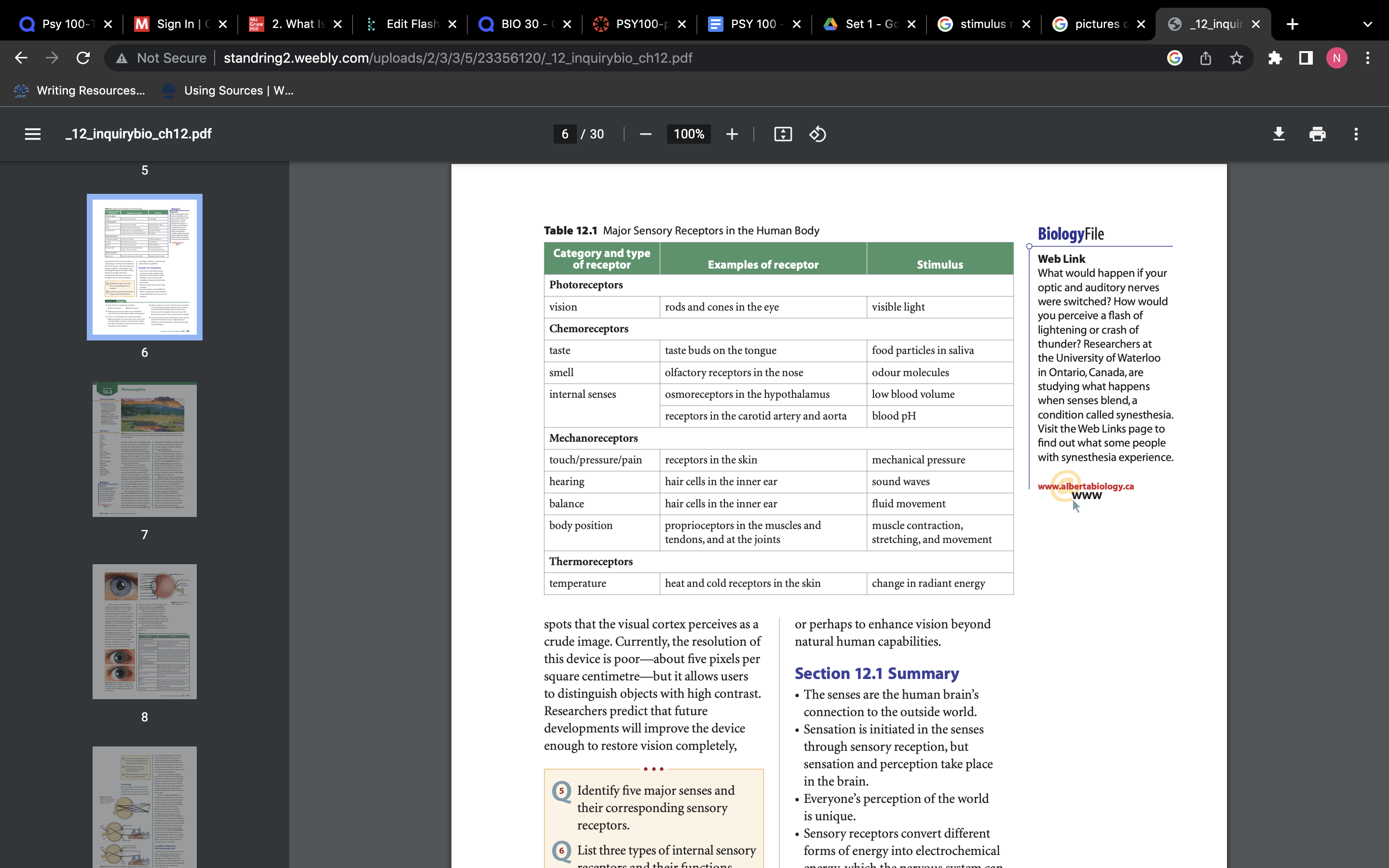
20
New cards
How are some action potentials perceived as smell as opposed to like touch or taste?
It is because sensory receptors are selective and have different neural pathways
They are selective by absorbing specific types of energy (ex. light energy or vibrations into action potential)
They are selective by absorbing specific types of energy (ex. light energy or vibrations into action potential)
21
New cards
What determines the intensity of action potential?
The frequency at which the neurons are fired, not the strength
22
New cards
What are the three types of receptors and what do they do?
Photoreceptors
Stimulated by light (e.g. rods & cones in the retina of our eyes)
Chemoreceptors
Stimulated by chemicals (e.g. taste buds on our tongue)
Mechanoreceptors
Stimulated by pressure, movement and vibration (e.g. hair cells of the inner ear, touch, hearing and equilibrium)
Stimulated by light (e.g. rods & cones in the retina of our eyes)
Chemoreceptors
Stimulated by chemicals (e.g. taste buds on our tongue)
Mechanoreceptors
Stimulated by pressure, movement and vibration (e.g. hair cells of the inner ear, touch, hearing and equilibrium)
23
New cards
What is synaethesia?
One sense induces another sense
ex. someone might see a music or taste a colour
ex. someone might see a music or taste a colour
24
New cards
What is phantom limb pain and how does it work?
When people have their limbs cut off but they still feel the pain in that limb
Even though the sensory receptors there are cut off, the parts of the brain and the nervous system that received that info is still there
Even though the sensory receptors there are cut off, the parts of the brain and the nervous system that received that info is still there
25
New cards
Where do all sensory signals go?
Thalamus
The greatest relay station
The greatest relay station
26
New cards
Where does visual, auditory and sensory info go, in order?
- Occipital lobes
- Temporal
- Parietal
- Temporal
- Parietal
27
New cards
What is the name for the sixth sense and what does it mean?
Extrasensory perception
Detecting info in the world without sensory input first
ex. telepathy (reading minds), precognition (predicting the future)
Detecting info in the world without sensory input first
ex. telepathy (reading minds), precognition (predicting the future)
28
New cards
What are the types of neurons and what do they do?
Sensory Neurons (afferent)
- Gather information from sensory receptors (i.e. touch/sight/sound/taste receptors) and transmit these impulses to the brain & spinal cord; typically have a short axon with long dendrites.
Interneurons (association neuron)
- Process and integrate incoming sensory info from sensory neurons and relay outgoing information to motor neurons; found primarily in the CNS. Do not have schwann cells, so not capable of repair.
Motor Neurons (efferent)
- Transmit information from the brain to muscles, glands, and other organs (effectors); typically have a long axon with short dendrites.
- Gather information from sensory receptors (i.e. touch/sight/sound/taste receptors) and transmit these impulses to the brain & spinal cord; typically have a short axon with long dendrites.
Interneurons (association neuron)
- Process and integrate incoming sensory info from sensory neurons and relay outgoing information to motor neurons; found primarily in the CNS. Do not have schwann cells, so not capable of repair.
Motor Neurons (efferent)
- Transmit information from the brain to muscles, glands, and other organs (effectors); typically have a long axon with short dendrites.
29
New cards
Do the sensory receptors or neurons convert stimuli (external energy) to electrical impules (action potential)?
Sensory receptors, so they can communicate that to the neurons
30
New cards
What is the absolute threshold?
The minimum amount of stimulus energy that a person can detect.
31
New cards
Do people have different thresholds?
YEAH
even you do, if you were going to walk 9m away from a clock ticking, the second time around, you might need to walk closer
even you do, if you were going to walk 9m away from a clock ticking, the second time around, you might need to walk closer
32
New cards
What determines the absolute threshold?
If you can detect it 50% of the time
ex. the clock can be heard ticking 4.5/9 times
ex. the clock can be heard ticking 4.5/9 times
33
New cards
Do we have low thresholds?
Yes, but our environment rarely lets us reach it
ex. a candle in a clear environment vs.a. cloudy one
ex. a candle in a clear environment vs.a. cloudy one
34
New cards
What is noise?
Irrelevant and competing stimuli—not only sounds but also any distracting stimuli for the senses.
35
New cards
What is the difference threshold / just noticeable difference?
The degree of difference that must exist between two stimuli before the difference is detected.
- If an artist had two colours, how different would colour B have to be in order for the artist to say the colours were different?
- If an artist had two colours, how different would colour B have to be in order for the artist to say the colours were different?
36
New cards
What determines JND?
If you can differentiate between the two stimuli 50% of the time
37
New cards
When do JND increase?
At very low levels of stimulation, changes can be detected easier
ex. if your friend is playing music and it was low and they turned it up higher, i am more likely to notice than if it was already high and they turned it up the same amount
ex. if your friend is playing music and it was low and they turned it up higher, i am more likely to notice than if it was already high and they turned it up the same amount
38
New cards
What's Weber's Law?
Logarithmic that linear, it is not the amount of change, but percentage it changes by
The principle that two stimuli must differ by a constant minimum percentage (rather than a constant amount) to be perceived as different.
ex. if you 1 to 20 candles (20 percent), you'll notice rather than 1 to 120 candles (1 percent), 6 to 120 candles (20 percent)
The principle that two stimuli must differ by a constant minimum percentage (rather than a constant amount) to be perceived as different.
ex. if you 1 to 20 candles (20 percent), you'll notice rather than 1 to 120 candles (1 percent), 6 to 120 candles (20 percent)
39
New cards
What is subliminal perception?
The detection of information below the level of conscious awareness.
40
New cards
Does the brain respond to info below the conscious level?
Yes, it can influence behaviour, but it has very little effect
41
New cards
Can our judgment of the absolute threshold be affected by many factors?
Yes.
ex. if someone gave you money every time you said yes to the clock, or took money away every time you said no
ex. if someone gave you money every time you said yes to the clock, or took money away every time you said no
42
New cards
What is signal detection theory?
A model for predicting how and when a person will detect weak stimuli, usually based on context.
The processes that underlie our judgement on whether we perceive a stimulus or not
An approach to perception that focuses on decision making about stimuli under conditions of uncertainty.
The detection of stimuli relies on many things BESIDES physical intensity and sensory ability of the observer, things like fatigue expectations and urgency can affect it
The processes that underlie our judgement on whether we perceive a stimulus or not
An approach to perception that focuses on decision making about stimuli under conditions of uncertainty.
The detection of stimuli relies on many things BESIDES physical intensity and sensory ability of the observer, things like fatigue expectations and urgency can affect it
43
New cards
What are the four outcomes according to signal detection and give an example.
When you are looking for a date for your cousins wedding and you find someone at the library, you examine certain factors (if they have a ring, if they seem interested, if you are attracted to them)
Hit: you ask, they say yes
Miss: they would have said yes and you didn't ask
False alarm: you asked because you thought they seemed interested and they said no
Correct rejection: you didn't ask and they would've said no anyway
Hit: you ask, they say yes
Miss: they would have said yes and you didn't ask
False alarm: you asked because you thought they seemed interested and they said no
Correct rejection: you didn't ask and they would've said no anyway
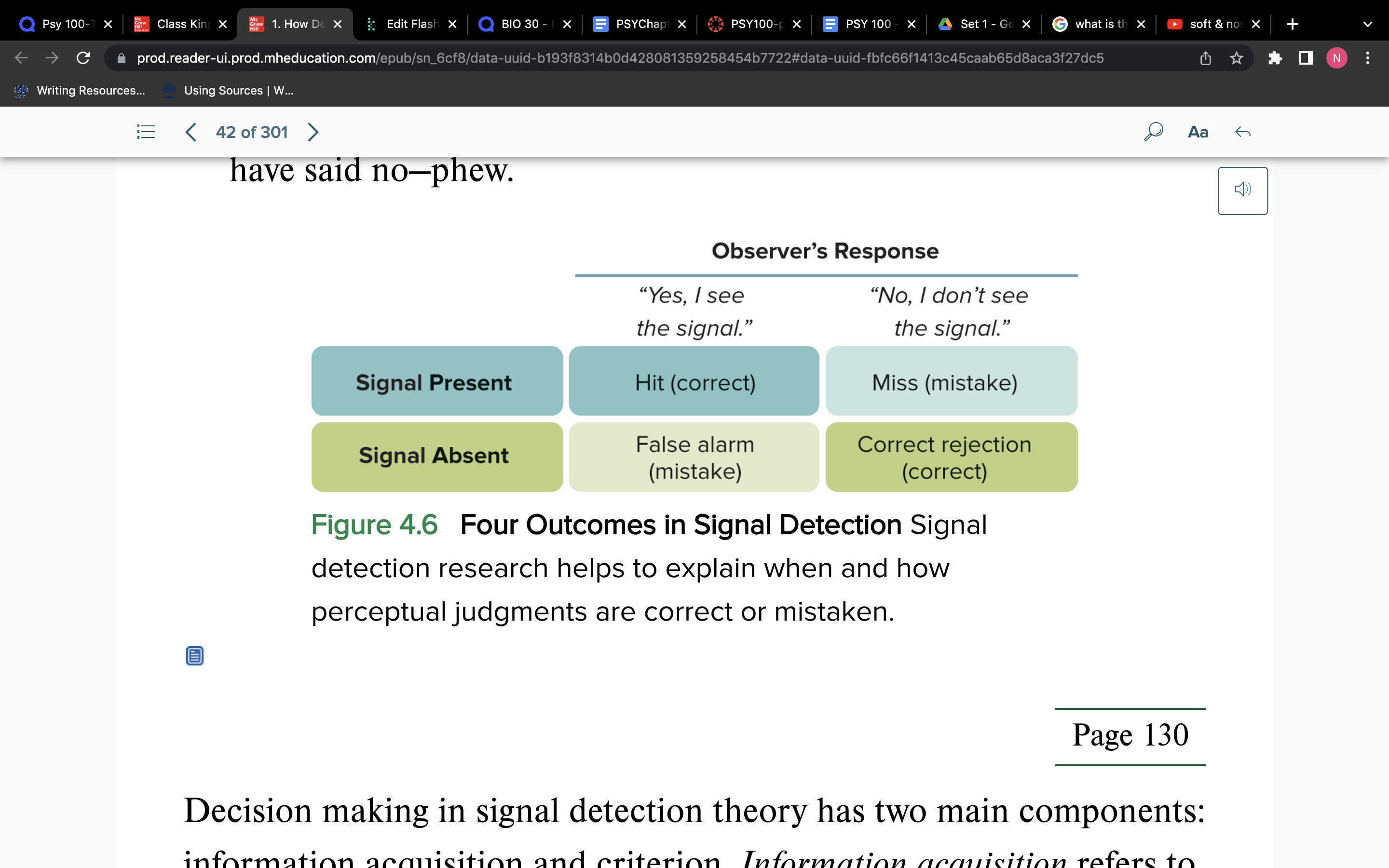
44
New cards
What are the two main components in decision making for signal detection theory and what do they mean?
Information acquisition refers to the gathering of relevant indicators
Criterion refers to the standards used to make the decision
Criterion refers to the standards used to make the decision
45
New cards
Give an example of information acquisition and criterion.
Back to the wedding example, information acquisition would be like seeing if they look available and attractive to you
Criterion would be weighing out the stakes, is it better to not ask and she wouldve said yes or ask and she says no
Criterion would be weighing out the stakes, is it better to not ask and she wouldve said yes or ask and she says no
46
New cards
How does a researcher using signal detection theory to understand results?
Presenting stimulus at different intensities, trials with no stimulus, and asking research participants to note the detection of the sound
47
New cards
What factors influence our perception?
Attention and perceptual set
48
New cards
What is attention?
The process of focusing awareness on a narrow aspect of the environment.
49
New cards
What is selective attention?
The act of focusing on a specific aspect of experience while ignoring others.
ex. ignoring the textbook and looking at your study light
ex. ignoring the textbook and looking at your study light
50
New cards
What is the cocktail party effect?
Being able to focus on one voice in a noisy room
ex. the prof is speaking and the rest of the room is packing up
ex. the prof is speaking and the rest of the room is packing up
51
New cards
What is the stroop effect?
Highly practiced stimuli like your name is hard to ignore
Since reading is a highly practiced stimuli which is automatic, it is hard to ignore, so when the ink is different on a word and you're trying to name the ink, you want to say the word instead
Since reading is a highly practiced stimuli which is automatic, it is hard to ignore, so when the ink is different on a word and you're trying to name the ink, you want to say the word instead
52
New cards
Can attention shift?
Yes
ex. if your prof is speaking and nicole is texting, you might shift your attention to her phone instead to see what she is texting dede
ex. if your prof is speaking and nicole is texting, you might shift your attention to her phone instead to see what she is texting dede
53
New cards
What is novel stimuli?
Those that are different, new and unusual (difference in size, colour and movement like big, bright and fast moving)
54
New cards
What can emotional stimuli do?
Influence attention therefore perception
55
New cards
Which is quicker at catching our attention? Neutral or emotional stimuli?
Emotional
ex. the word torture is more likely to catch your attention
ex. the word torture is more likely to catch your attention
56
New cards
What is emotionally-induced blindness?
When we encounter an emotion-based stimulus, we are less likely to pay attention to any other stimuli
ex. if you hear and see an ambulance, your attention is being taken away from the cars and stop signs around you
ex. if you hear and see an ambulance, your attention is being taken away from the cars and stop signs around you
57
New cards
What is inattentional blindness?
Failure to detect unexpected events when your attention is preoccupied by another task
ex. you are looking for a seat in the movie theatre and your friend is waving at you
ex. you are looking for a seat in the movie theatre and your friend is waving at you
58
New cards
When is inattentional blindness more likely to occur?
When the task is difficult and occupying and when the potentially distracting stimulus is very different from stimuli that are relevant to the task at hand
ex. groups where told to count how many passes that a basketball team did and a random lady in a gorilla suit ran by for like 5 seconds and half of them didn't notice until watching it over again
ex. groups where told to count how many passes that a basketball team did and a random lady in a gorilla suit ran by for like 5 seconds and half of them didn't notice until watching it over again
59
New cards
What is an example of inattentional and emotionally-induced blindness?
Texting and driving
they can take your attention away for the length of a football field 90km/hr
they can take your attention away for the length of a football field 90km/hr
60
New cards
What else influences perception?
Expectations
ex. you have two sets of cards. On the left, some spades are red. On the right, all spades are black. You pick out more spades on the right because you expect the spades to be black, so you unconsciously skip over red spade cards
ex. you have two sets of cards. On the left, some spades are red. On the right, all spades are black. You pick out more spades on the right because you expect the spades to be black, so you unconsciously skip over red spade cards
61
New cards
What is perceptual set?
BELIEVING IS SEEING
A predisposition or readiness to perceive something in a particular way.
A predisposition or readiness to perceive something in a particular way.
62
New cards
What is perceptual set act as? What does it reflect? Give me an example.
- Psychological filters in processing information in our environment
- Top-down influences on perception
ex. a child dealing with those cards would pick out more spades because they have less experience with cards
- Top-down influences on perception
ex. a child dealing with those cards would pick out more spades because they have less experience with cards
63
New cards
What is sensory adaptation?
- The brain's ability to filter out redundant sensory information
- A change in the responsiveness of the sensory system to the average level of stimulation.
ex. you adjust to the clothes on your body
If the clock is ticking, you eventually paying attention
When you get into a pool and its freezing at first, it eventually gets warmer for you
When it is dark in your room and you step out into the sun, you eventually get used to the light levels
- A change in the responsiveness of the sensory system to the average level of stimulation.
ex. you adjust to the clothes on your body
If the clock is ticking, you eventually paying attention
When you get into a pool and its freezing at first, it eventually gets warmer for you
When it is dark in your room and you step out into the sun, you eventually get used to the light levels
64
New cards
What is light?
- Electromagnetic waves that can be described in terms of wavelengths
- Our ability to detect visual stimuli depends on the sensitivity of our eyes to differences in light
ex. When you see beautiful colours of fall, your eyes and brain is just responding to the differences in light reflected by the various colours of leaves
- Our ability to detect visual stimuli depends on the sensitivity of our eyes to differences in light
ex. When you see beautiful colours of fall, your eyes and brain is just responding to the differences in light reflected by the various colours of leaves
65
New cards
How do lightwaves travel and how do you measure lightwaves? What do they reflect?
- Through space in waves
- The wavelength of light is the distance from the peak of one wave to the peak of the next
- The wavelength of light that is reflected represent the hue or colour of the object
- The visible light range is from 400-700 nanometres
- The wavelength of light is the distance from the peak of one wave to the peak of the next
- The wavelength of light that is reflected represent the hue or colour of the object
- The visible light range is from 400-700 nanometres
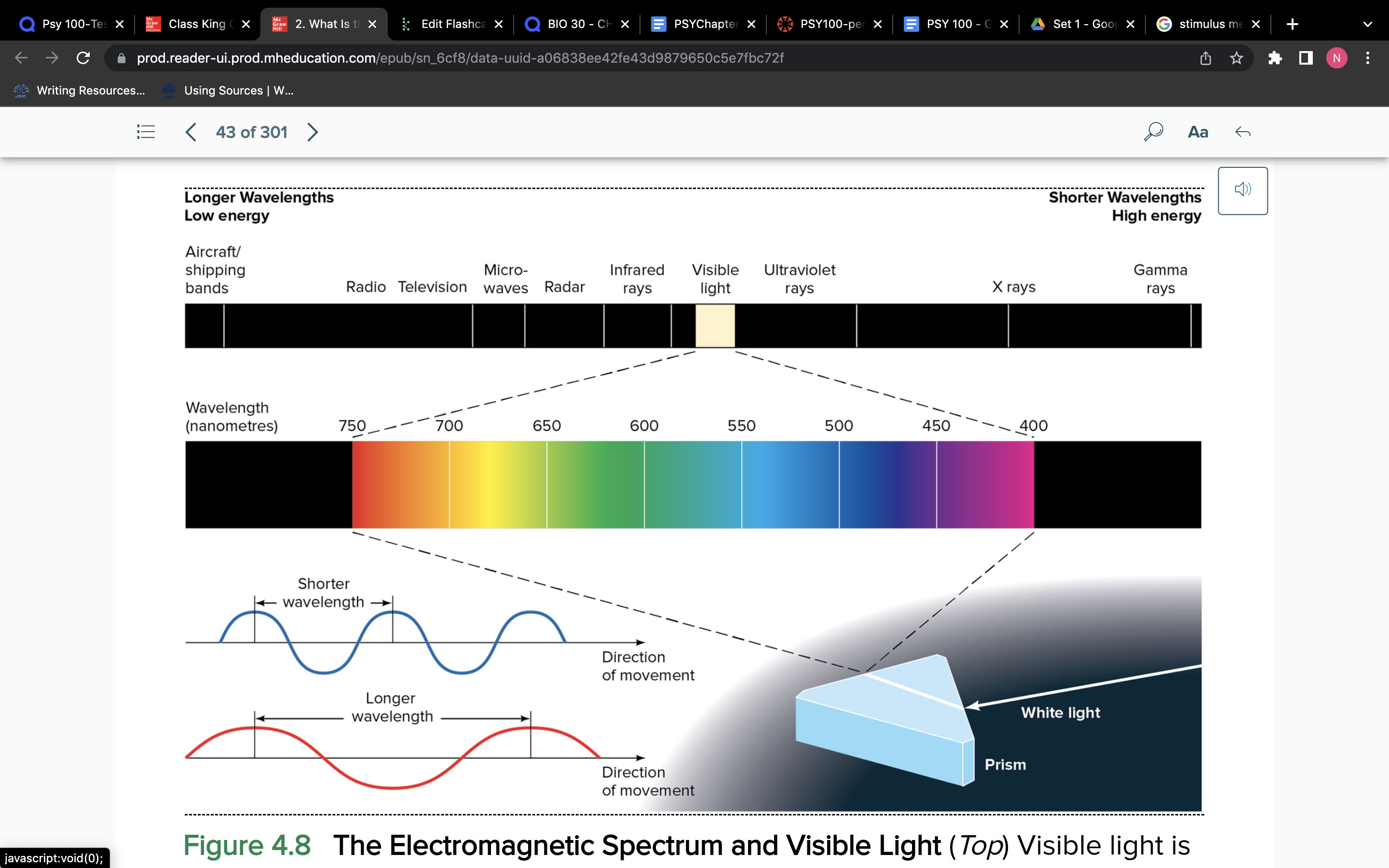
66
New cards
What is outside the range of visible light?
- Longer radio and infrared light (>700nm)
- Shorter X-ray and Ultraviolet light (400nm>)
- They continually bombard us, but we don't see them
- Shorter X-ray and Ultraviolet light (400nm>)
- They continually bombard us, but we don't see them
67
New cards
What determines the brightness of the stimulus?
- The height / amplitude of the lightwave

68
New cards
What is saturation?
- The purity of the wavelength
- The less white light it has, the more pure it is (the colours on the outside of the colour tree are more saturated and the closer they get to the middle aka the white, the more pastel they get)
- The less white light it has, the more pure it is (the colours on the outside of the colour tree are more saturated and the closer they get to the middle aka the white, the more pastel they get)
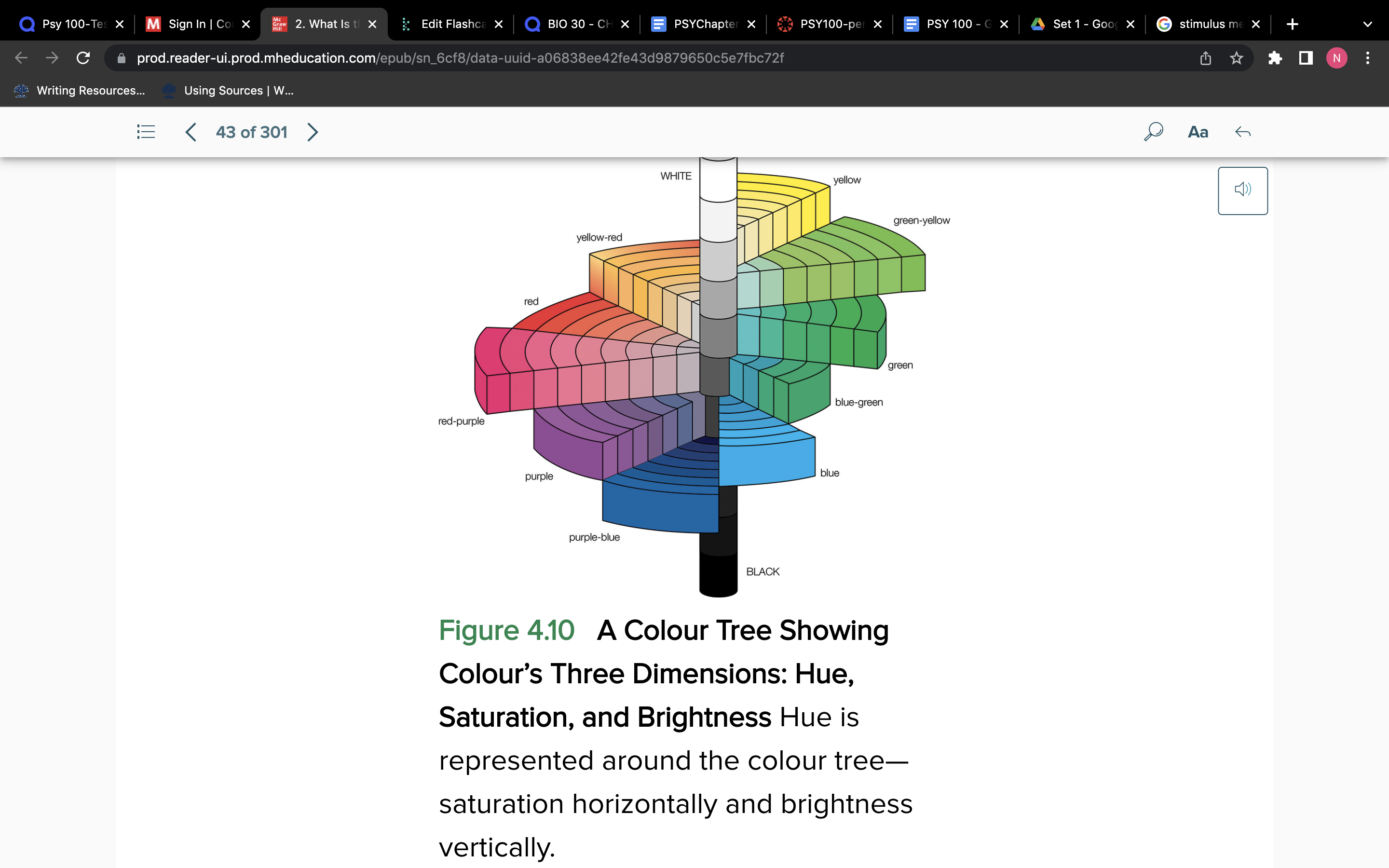
69
New cards
What are the three "outside" parts of the eye? What do they each do?
Sclera:
- White of the eye
- Protects eye, maintains shape
Iris:
- Coloured part of the eye
- The iris control muscles that control the pupils allowing a certain amount of light through the pupil
Pupil:
Hole in the eye, light enters through it
- White of the eye
- Protects eye, maintains shape
Iris:
- Coloured part of the eye
- The iris control muscles that control the pupils allowing a certain amount of light through the pupil
Pupil:
Hole in the eye, light enters through it
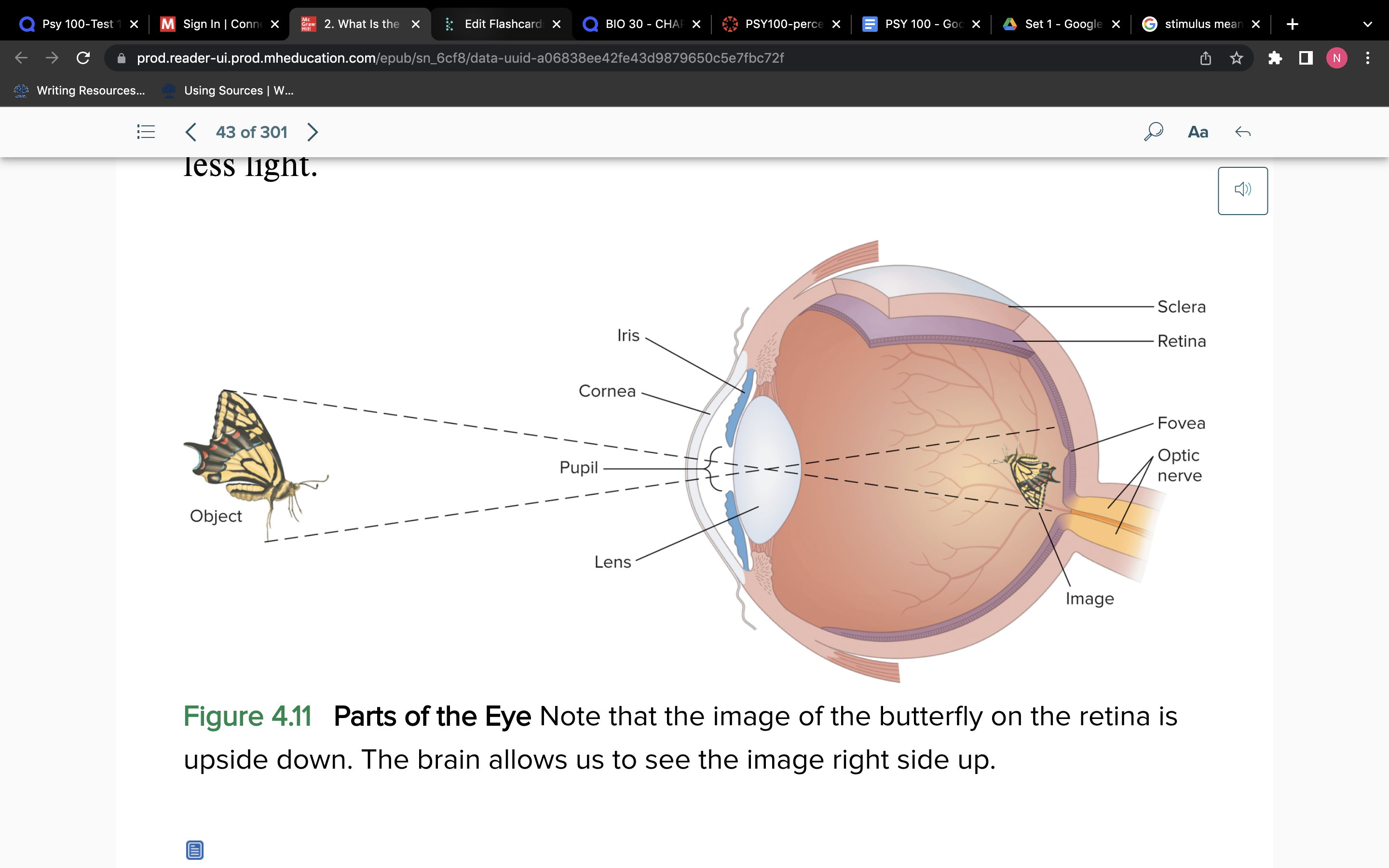
70
New cards
What are the two structures that bring the image into focus? Which does most of the bending?
Cornea:
Transparent part of sclera (clear membrane in front of the eye)
Lens:
- Helps focus light on retina (accommodation)
- CONVEX
- Transparent, disklike structure filled with gelatinous material
The curved part of the cornea, the lens does most of the fine-tune focusing
Transparent part of sclera (clear membrane in front of the eye)
Lens:
- Helps focus light on retina (accommodation)
- CONVEX
- Transparent, disklike structure filled with gelatinous material
The curved part of the cornea, the lens does most of the fine-tune focusing
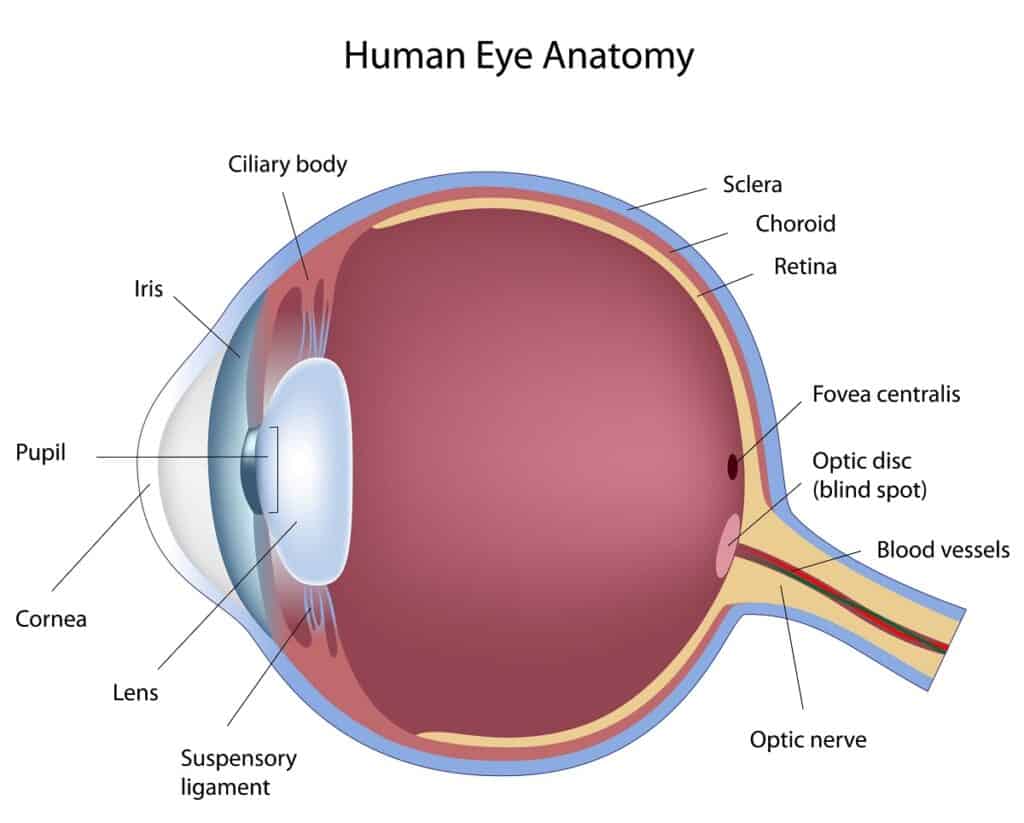
71
New cards
What happens when the ciliary muscle loosen / you are looking at something far away?
The suspending ligaments tighten --> lens thins
Your cornea reflection is sufficient enough so you don't need to bend the lens too much
Your cornea reflection is sufficient enough so you don't need to bend the lens too much
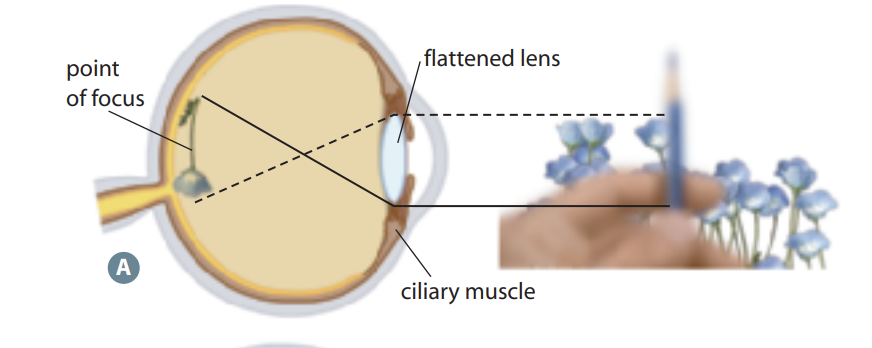
72
New cards
What happens when the ciliary muscle contracts / looking at something close?
The suspending ligaments loosen --> lens thickens (more refraction)
- To achieve more focus
- To achieve more focus

73
New cards
What happens to your lens when you get older?
They get filled up with cells and lose their flexibility, so it can no longer change shape from its flatten shape to its rounded shape
- Like a basketball that gets too filled up with air
- Like a basketball that gets too filled up with air
74
New cards
What is the retina?
- Back of the eye
- The multilayered, light-sensitive surface in the eye that records electromagnetic energy and converts it to neural impulses for processing in the brain.
- The multilayered, light-sensitive surface in the eye that records electromagnetic energy and converts it to neural impulses for processing in the brain.

75
New cards
What are rods?
- The receptor cells in the retina that are sensitive to light but not very useful for colour vision.
- Sensitive
- Respond to low-intensity light
- Detect black and white
- Predominant photoreceptor involved in peripheral vision
- Thin and long
- Contain rhodopsin (form of vitamin A)
- Sensitive
- Respond to low-intensity light
- Detect black and white
- Predominant photoreceptor involved in peripheral vision
- Thin and long
- Contain rhodopsin (form of vitamin A)
76
New cards
What are cones?
The receptor cells in the retina that allow for colour perception.
- Identify colour (specific)
- 1 cone per ganglion
- Require more light
- Short and fat
- Identify colour (specific)
- 1 cone per ganglion
- Require more light
- Short and fat
77
New cards
What is the fovea centralis?
- Center of the retina
- Allows for the finest detail
- Has a high concentration of cones
- Rods are everywhere in the retina except the fovea centralis
- Allows for the finest detail
- Has a high concentration of cones
- Rods are everywhere in the retina except the fovea centralis
78
New cards
Light enters the eye through _____ and strikes photoreceptors in the _____
Cornea, retina
79
New cards
Explain the process of light hitting the retina.
Rods and cones are at the back of the retina
- When light activates them, they send an action potential to the bipolar cells and then relayed to another layer of specialized cells called the ganglion
- When light activates them, they send an action potential to the bipolar cells and then relayed to another layer of specialized cells called the ganglion
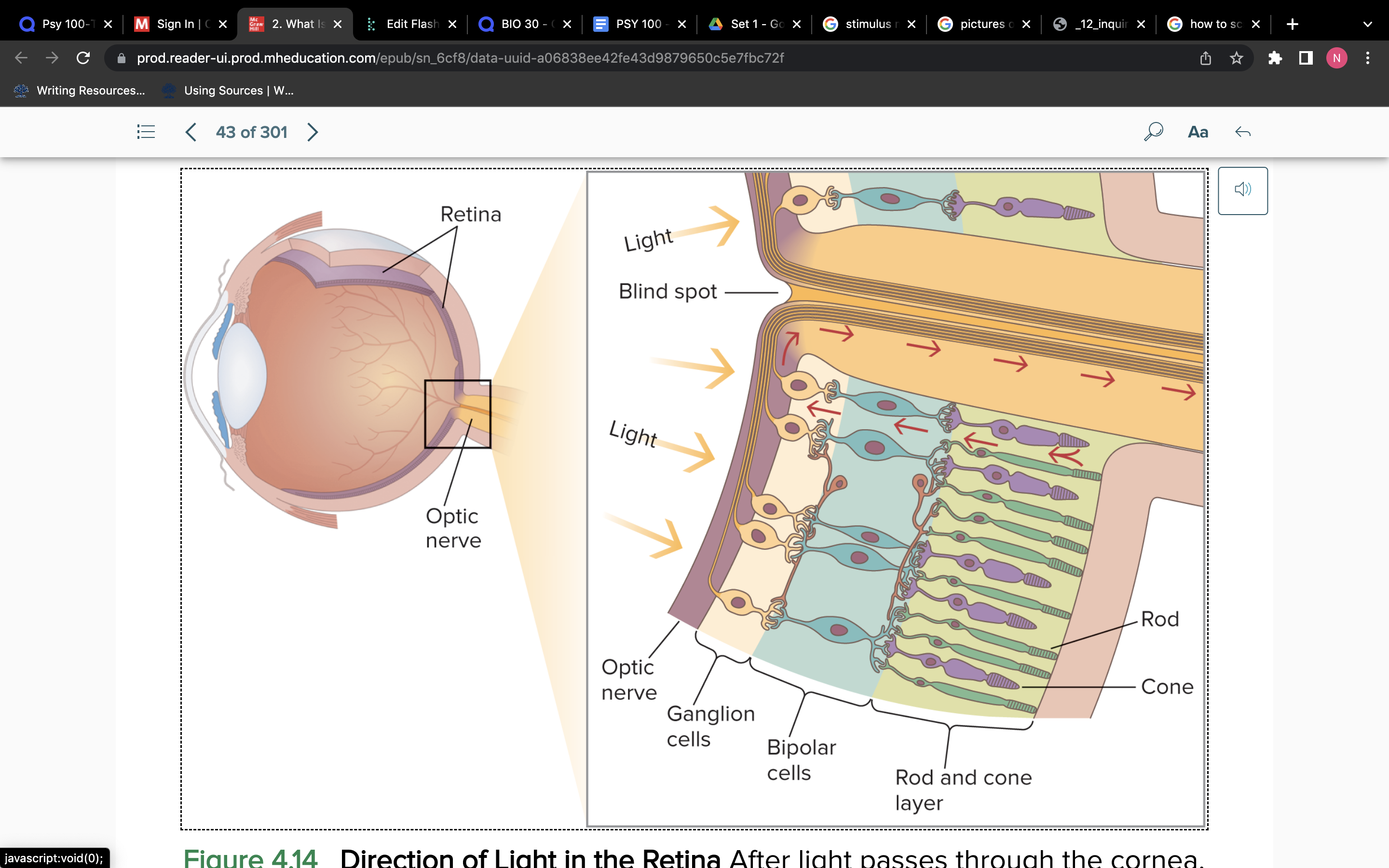
80
New cards
What do the axons in the ganglion cells make up? What does it do?
The optic nerve
- Carries visual information to the brain for further processing.
- Carries visual information to the brain for further processing.
81
New cards
Where is the blind spot?
- Point when optic nerve connects to retina
- No rods/cones
- No rods/cones
82
New cards
What happens in place of the blind spot?
It is replaced with what your brain would think would be there
- Top-down processing
- Top-down processing
83
New cards
What does light traveling in a straight line have to do with the brain?
Light in your left field of vision stimulate the right eye and vice versa

84
New cards
What is the optic chiasm? Why is it important
Nerve fibers from your optic nerve separate and cross the midline of the brain
- So the visual information originating from the two halves of the right retina (left field of vision), is transmitted to the right side of the occipital love and vise versa
- Then the info is processed and combined into a recognizable object by the visual cortex
- So the visual information originating from the two halves of the right retina (left field of vision), is transmitted to the right side of the occipital love and vise versa
- Then the info is processed and combined into a recognizable object by the visual cortex
85
New cards
What does the visual cortex do?
- Located in occipital lobe
- Major part of cerebral cortex responsible for vision
- Processed then sent to another part of the brain for further analysis
- Major part of cerebral cortex responsible for vision
- Processed then sent to another part of the brain for further analysis
86
New cards
What are feature detectors?
Specialized neurons in the visual cortex that detected certain features
Neurons in the brain’s visual system that respond to particular features of a stimulus
- Brain has neurons that are individually sensitive to different lines, angles and movements of a stimulus
- A specific neuron might fire when the stimulus moves downwards, then a different one when the angle of the stimulus changes
Neurons in the brain’s visual system that respond to particular features of a stimulus
- Brain has neurons that are individually sensitive to different lines, angles and movements of a stimulus
- A specific neuron might fire when the stimulus moves downwards, then a different one when the angle of the stimulus changes
87
New cards
How do we see the "whole stimulus"?
Various feature detectors, each responding to a different part of the stimulus
88
New cards
Does the brain learn to perceive through experience?
Yes
ex. May or the kittens without visual development in their early stages of life
ex. May or the kittens without visual development in their early stages of life
89
New cards
How is sensory information processed so fast?
Parallel processing
90
New cards
What is parallel processing?
The simultaneous distribution of information across different neural pathways
- Your senses aren't like a conveyor belt that processes each sense or stimuli at a time, it processes it all at once
- We perceive "what" and "where" all the time
- Your senses aren't like a conveyor belt that processes each sense or stimuli at a time, it processes it all at once
- We perceive "what" and "where" all the time
91
New cards
How do we integrate all visual information?
Binding
92
New cards
What is binding? If a toddler is running towards us, how are we supposed to identify them?
In the sense of vision, the bringing together and integration of what is processed by different neural pathways or cells.
Through binding, you can recognize the toddler coming towards us, their smile and movement all at once
- Within the vast network of cells, this set of neurons appears to bind together all the features of an object into unified perception
Through binding, you can recognize the toddler coming towards us, their smile and movement all at once
- Within the vast network of cells, this set of neurons appears to bind together all the features of an object into unified perception
93
New cards
What are the two main theories psychologists discovered to assess how we see colour?
- Trichromatic theory
- Opponent-process theory
- Opponent-process theory
94
New cards
What is the trichromatic theory?
Theory stating that colour perception is produced by three types of cone receptors in the retina that are particularly sensitive to different, but overlapping, ranges of wavelengths.
RED, BLUE OR GREEN
RED, BLUE OR GREEN
95
New cards
What supports the trichromatic theory?
Colourblindness
- COMPLETE colourblindness is rare, most people who have colourblindness can see some colours and not see some
- COMPLETE colourblindness is rare, most people who have colourblindness can see some colours and not see some
96
New cards
What didn't support the trichromatic theory?
Colour afterimage, which are sensations after an image is removed
ALSO some colours cannot exist together
ALSO some colours cannot exist together
97
New cards
What is opponent-process theory?
We see colour through processes that work against each other
A given cell might be excited by red and inhibited by green, whereas another cell might be excited by yellow and inhibited by blue.
Theory stating that cells in the visual system respond to complementary pairs of red-green and blue-yellow colours;
- If you stare at red long enough, your red-green system gets tired and you see a green afterimage.
A given cell might be excited by red and inhibited by green, whereas another cell might be excited by yellow and inhibited by blue.
Theory stating that cells in the visual system respond to complementary pairs of red-green and blue-yellow colours;
- If you stare at red long enough, your red-green system gets tired and you see a green afterimage.
98
New cards
How is the trichromatic AND opponent process theory right?
Red blue and green cones in the retina are connected to retinal ganglion cells in a way that the three-colour code theory is immediately translated into the opponent process theory
- Red cone can excite and green cone can inhibit ganglion cells
- Red cone can excite and green cone can inhibit ganglion cells

99
New cards
What is form perception?
Trying to pick out an object/organize it even with all the clutter around it
100
New cards
What is the figure-ground relationship?
The principle by which we organize the perceptual field into stimuli that stand out (figure) and those that are left over (ground).
- Some are ambiguous and hard to tell between the figure and the ground
THINK OF LIKE YOUR CRUSH AT A PARTY AND YOUR CRUSH IS THE FIGURE AND THE PEOPLE ARE THE BACKGROUND
ITS HOW YOU MAKE SENSE OF YOUR REALITY
- Some are ambiguous and hard to tell between the figure and the ground
THINK OF LIKE YOUR CRUSH AT A PARTY AND YOUR CRUSH IS THE FIGURE AND THE PEOPLE ARE THE BACKGROUND
ITS HOW YOU MAKE SENSE OF YOUR REALITY
